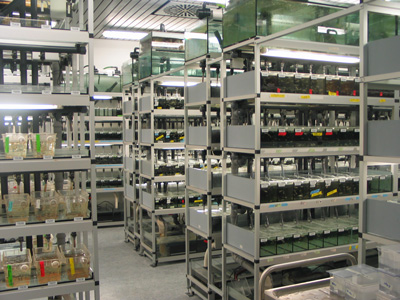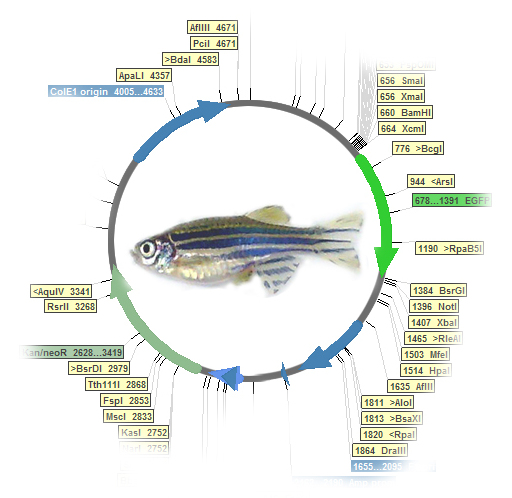About the EZRC
Aims
The European Zebrafish Resource Center at KIT aims to:
- Provide a permanent repository for zebrafish linesfrom European researchers
- Provide easy and cost-effective access to zebrafish lines for European researchers
- Provide sequencing services to the zebrafish community
- Host shelf screens and chemical screens as the first zebrafish screening center world-wide.
Background
Zebrafish (Danio rerio) and medaka (Oryzias latipes) are small fish that offer a rich repertoire of genetic, molecular and cellular manipulation tools that are of central importance for the BioInterfaces programme. Their unique properties (small size, numerous offspring, optical transparency of the embryo, amenability to genetic and chemical screens) make them ideal for the identification in vivo of new key targets and synthetic small molecules that control cell behavior. Indeed, they are currently the only vertebrate systems that permit screens of phenotypic changes in response to genetic alterations or small molecules in the living, intact vertebrate organism. Moreover, the monitoring and modelling of stem cell or immune cell behavior underlying vertebrate development and organ formation is possible at a resolution not matched by other systems. The regenerative capacity of adult tissues in zebrafish is extraordinary. Organs like kidney heart and brain regenerate with full functional recovery. This makes these small fishes ideal systems to study the regeneration of adult vertebrate organs. The availability of more than 15,000 mutants and transgenic lines is a vital resource for the BioInterfaces programme and the scientific community. These fish attract increasing attention for drug screens and whole animal toxicology studies and offer new paradigms in drug screening. More than 70% genes of the zebrafish genome have related genes in the human genome. As a consequence, zebrafish mutants serve as models for many human diseases.
Facility
The KIT houses the largest experimental fish facility in Europe with a capacity of more than 300,000 fish and more than 10 research groups working with zebrafish at KIT. It was thus logical to enlarge the facility further to serve as the European Zebrafish Resource Center (EZRC). In July 2012, we officially opened the EZRC. Zebrafish stocks are maintained mostly as frozen sperm. Frequently requested lines are also kept alive as well as a selection of wildtype strains. We have established efficient pipelines for sperm freezing, thawing and a database.We hold several thousand mutations in protein coding genes generated by TILLING in the Stemple lab of the Sanger Centre, Hinxton, UK and lines generated by ENU mutagenesis by the Nsslein-Volhard lab in addition to transgenic lines and mutants generated by KIT groups or brought in through collaborations. We also accept submissions on an individual basis and ship fish upon request to PIs in Europe and elsewhere.
This center does not only maintain and distribute a large number of existing mutant and transgenic zebrafish lines but also provides screening services and technologies such as imaging and high-throughput sequencing. In close interaction with physicists, engineers and IT specialists,we expanded the medium/high throughput screening technologies that have been recently established at KIT. Key areas include automation of embryo handling and automated image acquisition and processing. Our platform also involves the development of novel microscopy techniques (e.g. SPIM, DSLM, robotic macroscope) to permit high-resolution, real-time imaging in 4D. By association with the ComPlat platform, we can support also chemical screens and offer libraries with up to 20,000 compoundsin totalfor external users. As another service to the community the EZRC distributes plasmids (cDNAs, transgenes, Talen, Crispr/Cas9) maintained by the Helmholtz repository of BioParts (HeRBi) to the scientific community.
Furthermore the fish facility keeps a range of medaka stocks, maintained by the Loosli group.
HeRBi
HeRBI (Helmholtz Repository of BioParts) is a community action of the Helmholtz Initiative on Synthetic Biology (www.helmholtz.de/syntheticbiology) and provides a non-profit repository for storage and distribution of plasmids containing BioParts for synthetic biology applications, such as the construction of complex biological devices and systems.
The Helmholtz Initiative on Synthetic Biology is constituted by researchers from the German Cancer Research Center (DKFZ), Heidelberg, Helmholtz-Center for Infection Research (HZI), Braunschweig, German Research Center for Environmental Health (HMGU), Munich, Karlsruhe Institute of Technology (KIT), Research Center Jülich (FZJ), the University of Freiburg and the University of Heidelberg.
Plasmids are currently distributed by KIT, FZJ, DKFZ, and University of Freiburg. Only handling and shipment costs are charged.


